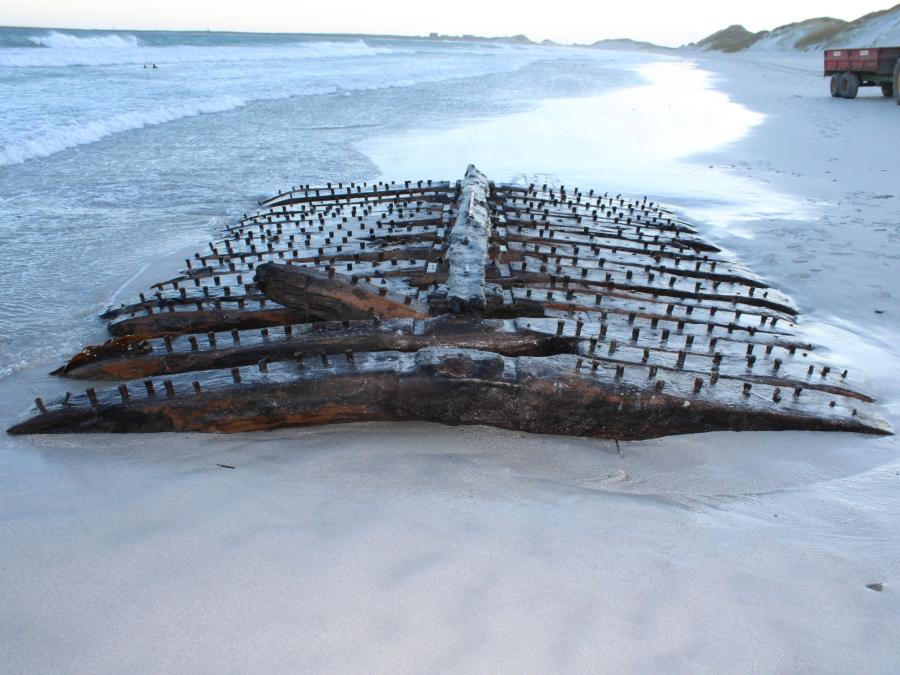Winter storms and coastal erosion reveal wreck saved by community
Updated December 2024
Rising from the intertidal deposits of Sand o’Erraby, a beach in Sanday, Orkney winter storms exposed a single large section of a wooden ship hull.
Sanday residents alerted the authorities and Wessex Archaeology was commissioned by Historic Environment Scotland (HES) and together with Dendrochronicle, to undertake rapid assessment, recording and dendrochronological sampling of a section of wooden wreck.
Identified as the midships section of the bottom of the hull, the section was upside down and the degraded keel visible. Large treenails were used as the fastening between the frames and planking and with minimal evidence for iron fastenings for the planking, construction techniques suggested post-medieval date between the 16th and 19th centuries; with the 17th-18th centuries looking to be the most likely on first inspection.


Sanday residents played a vital role in the first steps in recording the shipwreck, and funding from the North Isles Landscape Partnership Scheme enabled Wessex Archaeology to carry out maritime archaeology training and workshops with the local community, delivered alongside Sanday Heritage Group and archaeological conservator from Orkney, Wendy Robinson.
The future of the wreck’s timbers was secured thanks to an £79,658 grant from the National Heritage Memorial Fund (NHMF) to Orkney Islands Council, on behalf of the Sanday community, for a huge freshwater tank to house the wreck and protect it from deterioration. Wessex Archaeology were on hand to oversee the delicate task of transferring the timbers to their new home.
Our Senior Marine Archaeologist, Ben Saunders, said: “We're delighted to be involved in the efforts to conserve and understand this fascinating wreck, and working with the people of Sanday to do so.”
The custom-designed tank, fabricated by Aberdeen-based Waterfront Stainless Steel at their Orkney workshop, features a roll-top lid to enable access for researchers and interested visitors by appointment. The tank is situated alongside Sanday’s Heritage Centre where it will stay for the next 2 to 3 years.
Also on hand throughout the two-day operation was the Council’s Culture Team Manager Nick Hewitt, who approached NHMF for their assistance:
“There was definitely a palpable sense of relief today, from everyone who’s been involved, as the last of the timbers were lowered into the tank.
“While the ship’s past remains a mystery for now, it’s entirely possible it hails from one of the naval superpowers of the time.
“Thanks to the speedy help of National Heritage Memorial Fund, researchers now have the opportunity to carry out the work needed to try and establish the ship’s history.”
Dendrochronology and further research
In December 2024, Wessex Archaeology and Dendrochronicle received funding from Historic Environment Scotland’s (HES) Historic Environment Grants Programme to enable the dendrochronological dating of 19 samples recovered from historic timbers recovered from Sand o’Erraby, a beach in Sanday, Orkney Islands.
The additional research will allow further insight into shipbuilding and woodworking techniques during the relevant period and research alongside the Sanday community into the potential identity of the wreck. Thanks to this funding, there will also be full reporting of results and archiving with HES and the Orkney Historic Environment Record.
Over the coming months the historic timber specialists at Dendrochronicle will undertake dendrochronological assessment then analysis of the tree-ring samples. It is hoped that this will provide precise dating evidence for the vessel and provide clues as to where she was built.
Next steps
The assessment will give the dendrochronologist an overview of the material, establishing the suitability of each sample for analysis. The analysis will then use conventional ring-width dendrochronology to obtain tree-ring width sequences from each sample.
Wessex Archaeology’s Coastal & Marine specialists will take the results of the dating and provenance of the timbers and conduct further study to establish what the timbers can tell us about the development of shipbuilding during a time when large sailing vessels were the pinnacle of technological advancement, regarded as the most complex technology societies were producing.
Working with community researchers and the Sanday Heritage Centre the project will look at the archive material relating to wrecks in Orkney to better understand the overall resource and bring together an island-centric archive of wrecks. This will include material from Orkney Archives and more widely from National Records of Scotland and The National Archives. If the dendrochronological analysis allows, they may also consult archives at the suggested origin of the wreck.
These next stages are very important in identifying the significance of the wreck: where it came from, when it was built and what it can tell us about the networks of maritime trade and exchange which flowed through and around Orkney and connected the islands to the world. Join us in our own voyage of discovery over the coming months as we bring together science, history and engineering to place the wreck within these global networks.
